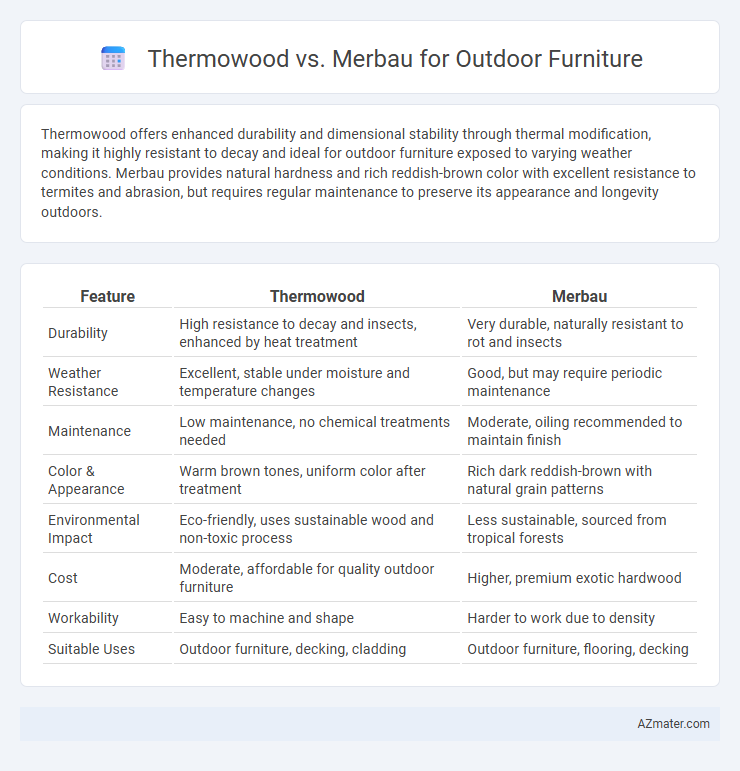Thermowood offers enhanced durability and dimensional stability through thermal modification, making it highly resistant to decay and ideal for outdoor furniture exposed to varying weather conditions. Merbau provides natural hardness and rich reddish-brown color with excellent resistance to termites and abrasion, but requires regular maintenance to preserve its appearance and longevity outdoors.
Table of Comparison
| Feature | Thermowood | Merbau |
|---|---|---|
| Durability | High resistance to decay and insects, enhanced by heat treatment | Very durable, naturally resistant to rot and insects |
| Weather Resistance | Excellent, stable under moisture and temperature changes | Good, but may require periodic maintenance |
| Maintenance | Low maintenance, no chemical treatments needed | Moderate, oiling recommended to maintain finish |
| Color & Appearance | Warm brown tones, uniform color after treatment | Rich dark reddish-brown with natural grain patterns |
| Environmental Impact | Eco-friendly, uses sustainable wood and non-toxic process | Less sustainable, sourced from tropical forests |
| Cost | Moderate, affordable for quality outdoor furniture | Higher, premium exotic hardwood |
| Workability | Easy to machine and shape | Harder to work due to density |
| Suitable Uses | Outdoor furniture, decking, cladding | Outdoor furniture, flooring, decking |
Introduction to Thermowood and Merbau
Thermowood is a type of heat-treated wood known for its enhanced durability, dimensional stability, and resistance to decay, making it ideal for outdoor furniture applications. Merbau, a dense hardwood from Southeast Asia, boasts natural oils and high density that provide excellent weather resistance and long-lasting strength. Both materials offer unique benefits for outdoor use, with Thermowood standing out for its eco-friendly treatment process and Merbau prized for its rich color and toughness.
Key Characteristics of Thermowood
Thermowood is a heat-treated softwood known for its enhanced durability, stability, and resistance to decay, making it ideal for outdoor furniture exposed to varying weather conditions. The thermal modification process reduces the wood's moisture content, significantly improving dimensional stability and resistance to fungal and insect attacks without the use of chemicals. Compared to Merbau, which is a dense tropical hardwood valued for its natural hardness and rich color, Thermowood offers a more environmentally friendly option with sustainable sourcing and consistent performance in outdoor applications.
Key Characteristics of Merbau Wood
Merbau wood is prized for its natural durability and rich, reddish-brown color that deepens with age, making it highly resistant to outdoor elements such as moisture, insects, and decay. Its dense, hard texture provides excellent strength and stability for outdoor furniture, ensuring long-lasting performance and minimal maintenance. Compared to Thermowood, Merbau offers superior natural weather resistance without the need for chemical treatments, showcasing its sustainability and robustness in exterior applications.
Durability Comparison: Thermowood vs Merbau
Thermowood offers enhanced durability by undergoing heat treatment, increasing resistance to decay, moisture, and insect attacks, making it a sustainable choice for outdoor furniture. Merbau, a naturally dense hardwood, provides exceptional strength and weather resistance, often outperforming many tropical hardwoods in outdoor longevity. While Merbau's natural oils offer inherent protection, Thermowood's modified fiber structure ensures greater stability and resistance to environmental changes over time.
Weather Resistance and Outdoor Performance
Thermowood offers superior weather resistance due to its heat-treatment process, which enhances durability and reduces moisture absorption, making it ideal for outdoor furniture exposed to varying climates. Merbau, a dense hardwood rich in natural oils and tannins, naturally withstands moisture, insects, and decay but may require regular maintenance to maintain its outdoor performance. Both materials provide excellent longevity outdoors, with Thermowood excelling in dimensional stability and Merbau offering robust hardness and resistance to fungal attacks.
Aesthetic Appeal and Color Variations
Thermowood offers a rich, warm brown hue with subtle golden undertones that darken gracefully over time, enhancing outdoor furniture with a natural and elegant appearance. Merbau, known for its deep reddish-brown color and pronounced grain patterns, provides a striking visual contrast that remains vibrant with proper maintenance. Both woods present distinctive aesthetic appeal, but Thermowood's uniform color and smooth texture suit modern designs, while Merbau's rich tones and natural variations complement more traditional or rustic outdoor furniture styles.
Maintenance Requirements for Each Wood
Thermowood requires minimal maintenance due to its enhanced durability and resistance to rot and insects, typically needing only annual cleaning and occasional oil treatment to retain its appearance. Merbau demands more frequent upkeep, including regular cleaning and annual applications of UV-protective sealants to prevent surface cracking and color fading. While Thermowood's thermal modification improves dimensional stability reducing warping risks, Merbau's natural oils offer good resistance but necessitate consistent maintenance to maintain outdoor performance.
Environmental Impact and Sustainability
Thermowood, produced through heat treatment of fast-growing softwoods like pine, offers enhanced durability and resistance without chemical additives, resulting in a lower environmental footprint compared to tropical hardwoods. Merbau, a dense and naturally durable hardwood from Southeast Asia, faces sustainability challenges due to deforestation and slower growth rates, raising concerns about its long-term availability and ecological impact. Choosing Thermowood over Merbau supports the use of renewable resources with reduced carbon emissions and promotes sustainable forestry practices crucial for eco-friendly outdoor furniture.
Cost Analysis: Thermowood vs Merbau
Thermowood offers a cost-effective solution for outdoor furniture due to its lower initial price and reduced maintenance expenses compared to Merbau. Merbau, while typically more expensive upfront, provides superior durability and natural resistance to weathering, potentially lowering long-term replacement costs. Evaluating total cost of ownership, including lifespan and upkeep, positions Thermowood as budget-friendly, whereas Merbau appeals to those prioritizing longevity and premium quality.
Best Choice for Outdoor Furniture: Final Verdict
Thermowood offers superior dimensional stability and resistance to decay due to its heat treatment process, making it an excellent environmentally friendly choice for outdoor furniture. Merbau, known for its natural durability and rich reddish-brown color, provides exceptional strength but requires regular maintenance to prevent weathering and insect damage. For long-lasting, low-maintenance outdoor furniture, Thermowood is the best choice, combining sustainability with resilience against harsh outdoor conditions.

Infographic: Thermowood vs Merbau for Outdoor Furniture
 azmater.com
azmater.com